Manufacturing of paper and cardboard
Paper consists of a net of cellulose fibers. Cellulose fibers are made by treating wood which consists largely of cellulose and lignin. Several different factors can affect the properties of the paper such as length of fibers, filling additives (for example, clay or chalk) or different fiber pre-treatment. By doing so, many different types of paper can be produced.
To make paper pulp, you start by barking the wood and then working it to expose its fibers. There are different methods to do this and the method is adapted to the paper you wish to produce. Read more below about the process!
Use
and quality
The advantage of cardboard material is that it comes from a renewable raw material. At the same time, the recycling system for paper and cardboard is well developed and the recycling rate is high. The use of recycled material is also widespread. Cardboard is also biodegradable and is not as problematic as other materials if it gets into nature. Disadvantages are that paper production is water-intensive and energy-intensive, and can give rise to chemical emissions. The use of chemicals is high.
Take sustainable paper decisions!
- Minimize the use of material. A lighter carton gives less emissions. But the carton still has to fulfill the function of protecting the products since the products generally have a higher environmental impact than the carton itself.
- Use recycled material. Recycled material saves resources.
- Evaluate the suppliers. CO2 emissions vary widely between different suppliers.
- Encourage consumers to reuse if possible, and if not, to recycle the carton.
- Avoid mixing materials.
- Avoid using gold paint to facilitate recycling.

Paper packaging
and their sustainability foot print
Paper packaging is cellulose-based and renewable. However, the climate impact of the carton is strongly linked to the energy mix used in manufacturing. One Swedish manufacturer estimated the climate impact at 0.24 Kg CO2 equivalents per kilogram of false board, while the European average was 1.3 Kg CO2 equivalents per kilogram of false cardboard, according to the Swedish Food Agency's report.
Corrugated cardboard gives rise to 0.44 Kg CO2 equivalents / kg corrugated cardboard calculated on corrugated cardboard of 18% virgin raw material and 82% recycled raw material and European electricity mix (almost only fossil energy).
An easy way to make a big difference
Recycling
In 2018, 82% of the paper, cardboard, and corrugated cardboard were recycled on the market in Sweden (Statistics Sweden). Material recycling of paper packaging is advantageous because it saves the earth's resources - a ton of recycled paper corresponds to 14 trees and it only takes 1/3 of the energy to produce the paper from recycled material compared to virgin material. 37% of the carbon dioxide emissions made in the production of virgin cardboard will be saved if the raw material comes from recycled material.
When the paper packaging has become waste, they are collected and transported to sorting facilities where they are separated from foreign objects and pressed together into large bales. The bales are driven to the recycler, in Sweden almost always to the Fiskeby Board. They analyze the bales to see what type of paper they consist of (corrugated cardboard, other paper packaging, other paper or other material). Then the cardboard is inserted into a large rotating drum together with large amounts of water.
The drum functions much like a washing machine and in it the packages are dissolved in fibers that are separated from other materials, such as plastic layers. The fiber material is rinsed out over a special cloth with holes in it. The water runs off and the fiber pulp can then continue into the paper machine where it is pressed together in several layers into cardboard. The cardboard is dried and treated with chalk, clay and binder to obtain the selected final quality. The cardboard is rolled up and sold to packaging manufacturers and printing companies.
The residual material is sorted away from the process and used for energy recovery. The paper fibers can be used 6-7 times as they wear out and become shorter for each recycling cycle. When they are obsolete, they can be used for energy. The corrugated cardboard and paper recycling process is a durable process. An important factor to think about in order to make recycling easier is to not mix materials, such as having a plastic window in the carton, and avoiding gold paint if the carton is to be lacquered because gold color has historically created problems in the process.

In 2018, 82% of the paper, cardboard, and corrugated cardboard were recycled on the market in Sweden (Statistics Sweden). Material recycling of paper packaging is advantageous because it saves the earth's resources - a ton of recycled paper corresponds to 14 trees and it only takes 1/3 of the energy to produce the paper from recycled material compared to virgin material. 37% of the carbon dioxide emissions made in the production of virgin cardboard will be saved if the raw material comes from recycled material.
When the paper packaging has become waste, they are collected and transported to sorting facilities where they are separated from foreign objects and pressed together into large bales. The bales are driven to the recycler, in Sweden almost always to the Fiskeby Board. They analyze the bales to see what type of paper they consist of (corrugated cardboard, other paper packaging, other paper or other material). Then the cardboard is inserted into a large rotating drum together with large amounts of water.
The drum functions much like a washing machine and in it the packages are dissolved in fibers that are separated from other materials, such as plastic layers. The fiber material is rinsed out over a special cloth with holes in it. The water runs off and the fiber pulp can then continue into the paper machine where it is pressed together in several layers into cardboard. The cardboard is dried and treated with chalk, clay and binder to obtain the selected final quality. The cardboard is rolled up and sold to packaging manufacturers and printing companies.
The residual material is sorted away from the process and used for energy recovery. The paper fibers can be used 6-7 times as they wear out and become shorter for each recycling cycle. When they are obsolete, they can be used for energy. The corrugated cardboard and paper recycling process is a durable process. An important factor to think about in order to make recycling easier is to not mix materials, such as having a plastic window in the carton, and avoiding gold paint if the carton is to be lacquered because gold color has historically created problems in the process.
